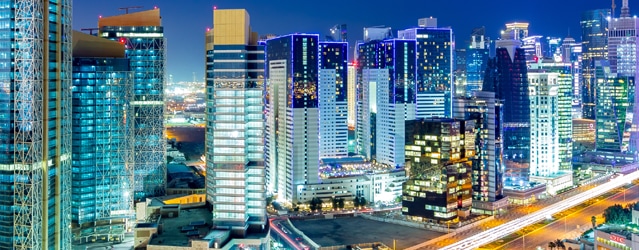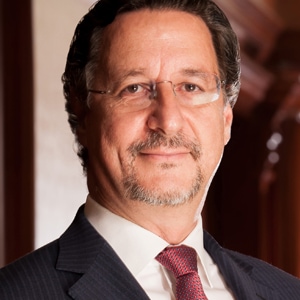Qatar’s government borrows heavily and reaches out to private sector.

Qatar is determined to keep spending heavily on infrastructure in the run-up to the 2022 FIFA World Cup, even as it struggles to maintain its high standard of living by going deeper into debt. The country, rich in oil and gas resources, claims the massive spending is aimed at creating a knowledge-based economy, and not just facilitating the sporting event. Yet liquidity is drying up in Qatar’s banking system as low oil prices pinch government income; 2016 saw the country’s first fiscal deficit in 15 years.
Doha Bank, a leading bank in Qatar, says it has coped with the tighter liquidity by growing customer deposits. “With a relationship-driven approach and strong brand equity in the local market, we are able to leverage our significant customer base in attracting deposits,” says David Challinor, Doha’s chief financial officer. “In addition, our international branch network—coupled with strong global relationships—allows us to source deposits and other forms of funding internationally.” As a result, Doha Bank’s liquidity position has always been better than the system average, he says.
Qatari banks are relying more heavily on foreign funds than ever before. Central bank data show the net foreign liability position of the country’s banks has risen above $40 billion to a new record.
Meanwhile, growth in Qatar’s economy has slowed dramatically from the double-digit gains recorded in the recent past. “The economy is reaching a mature and stable stage, which was not the case prior to 2012, when the economy was still emerging,” says Bassel Gamal, group CEO of Qatar Islamic Bank (QIB). “We are still experiencing a healthy, constant growth and, more importantly, we remain confident in the state’s willingness and financial ability to continue its substantial investments in infrastructure and toward the economy’s diversification.”
Qatar’s real GDP increased by 3.6% last year, and economic growth is expected to accelerate from about 3.2% in 2016 to 3.8% in 2017, and 4.1% in 2018, according to Gamal. “The construction and transport sectors are expected to receive the majority of the investments, due to large current and upcoming projects,” he says. “The large influx of expatriate professionals and workers to implement these projects is generating demand for a wide range of services.”
QIB controls 43.5% of the Islamic banking market in Qatar and 11.5% of the overall market. “To keep growing, we will need to further diversify our revenue streams by strengthening the relationship with existing customers, while attracting new ones—many of whom might not have banked with an Islamic financial institution previously,” Gamal says.

Ziad Makkawi, CEO of Qatar First Bank (QFB), which listed on the Qatar Stock Exchange in April, says: “Our focus as an institution is not on competing with the larger banks for big corporate clients, but rather on the private client sector. We believe this sector to be grossly underserved, both in terms of offerings and quality.”
Makkawi says Qatar is relatively better positioned than its GCC neighbors to continue its development plans. “What we are seeing more recently is a realization by the government that it cannot do it alone, that it must encourage and partner with the private sector in order to fulfill its promise,” he says.
Jason Tuvey, Middle East economist at Capital Economics in London, says Qatar’s real GDP growth slowed to 1.4% at an annual rate in the first quarter of 2016, owing to a number of factors, including a contraction in the oil and gas sector. In addition, non-hydrocarbon growth in the second quarter was the weakest since early 2000, he says, as the government scaled back some of its more ambitious projects.
With a $60-a-barrel break-even price for oil and the country’s enormous savings, Qatar is in a relatively strong position, according to Tuvey. “Qatar doesn’t have the same problems as a country such as Saudi Arabia with its large population,” he says. “There are only 300,000 Qataris.” Foreign workers make up the bulk of Qatar’s population of 2.3 million people.
World Cup preparations will surely be a stimulus. In addition, plans for special economic zones will help diversify the economy and attract more foreign investment, Tuvey says. In June 2016, the Qatar government passed a law to establish three private economic zones that allow 100% foreign ownership and repatriation of capital and revenues. Manateq, a government company, will run the zones in Ras Bufontas (near the airport), Al Karana (industrial area) and Um Alhoul (near Hamad port).
Meanwhile, initial gas production is coming onstream from the $10 billion Barzan gas project. Barzan, a joint venture between Qatar Petroleum and Exxon Mobil, will help meet growing domestic demand for energy, as well as supply products for export.
Omar al-Nakib, senior economist at National Bank of Kuwait, says Qatar’s fiscal deficit will be financed primarily through debt issuance. In addition, the government has embarked on a “concerted round of fiscal consolidation,” he says. “It is merging ministries, scaling back infrastructure projects and cutting subsidies on domestic fuel and utilities.”
The largest sovereign issuance to date by Qatar was a three-part, $9 billion dollar-denominated international bond in May. “Fiscal buffers are ample,” al-Nakib says, “given that the government could also draw upon an estimated $256 billion worth of assets under management at the Qatar Investment Authority, the country’s sovereign wealth fund.”
GFmag.com Data Summary: Qatar
|
Central Bank: Qatar Central Bank | |||
|
International Reserves |
$36,923.4 billion | ||
|
Gross Domestic Product (GDP) |
$185.4 billion* | ||
|
Real GDP Growth |
2013 13.0% |
2014 6.1% |
2015* 6.5% |
|
GDP Per Capita—Current Prices |
$76,576* | ||
|
GDP—Composition By Sector* |
agriculture: 0.1% |
industry: 55.7% |
services: 44.1% |
|
Inflation |
2013 3.1% |
2014 3.3% |
2015* 1.7% |
|
Public Debt (general government |
2013 32.6% |
2014* 32.6% |
2015* 35.8% |
|
Government Bond Ratings (foreign currency) |
Standard & Poor’s AA |
Moody’s Aa2 |
Moody’s Outlook NEG |
|
FDI Inflows |
2013 $840 million |
2014 $1,040.4 million |
2015 $1,070.9 million |
* Estimates Source: GFMag.com Country Economic Reports



